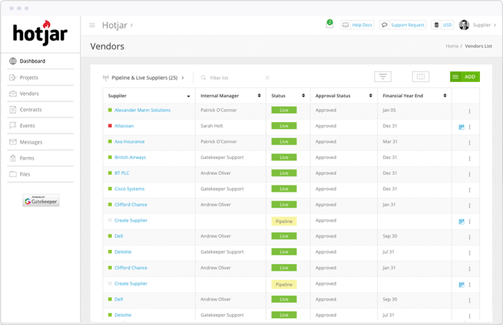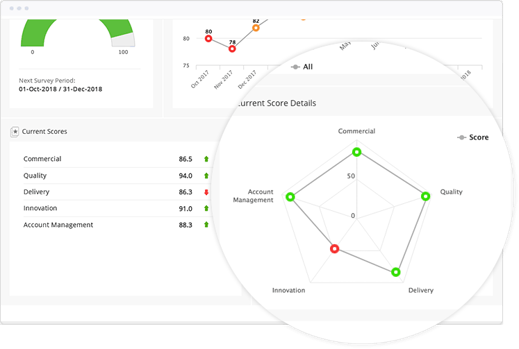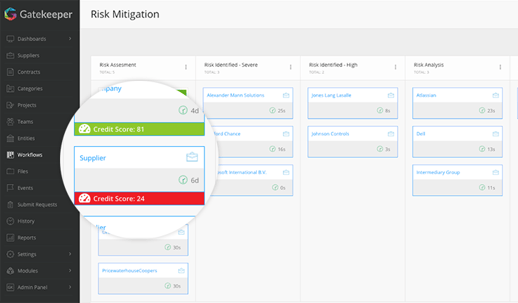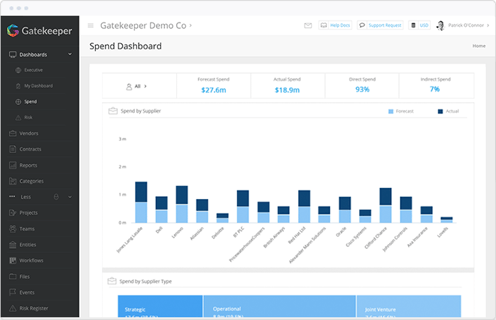Effective supplier management programs can yield multiple benefits including deeper relationships across the supply chain, more profitable agreements and improved supplier performance.
A business can only operate as well as the suppliers it uses, so these programs are critical for long-term success.
At an operational level, successful supplier management programs can help businesses to streamline the amount of third-parties they use and minimise the level of supplier risk introduced to the business.
In this article, we take a look at how you can deliver an effective program when supported by supplier management software.
How well do you know your supplier base?
Building a supplier management program can be difficult if your business doesn’t have a single, holistic view of its contract portfolio. It’s important to know:
- Which and how many suppliers you have covering different services
- What the actual spend vs forecast spend is for each supplier
- If your suppliers are up-to-date with their compliance requirements
- If supplier management KPIs are being met
- If your suppliers are fulfilling contract obligations
- The level of risk each supplier introduces to your business
- When renewal dates are due and what alternatives are available
If information about your suppliers is kept in disparate sources such as spreadsheets, team member’s heads or in emails buried in someone’s inbox, you won’t be able to fully know and understand the state of your supplier base.
An effective supplier management program starts with a centralised view of your third-parties and all their relevant information."
Implementing supplier management software that offers a centralised repository is the first step you should if you lack visibility of your supplier base. Not only will a dedicated solution give you the overview you need, but it will also be integral to building your supplier management program from the ground up. Let’s see how.
1. Automate supplier processes
Processes such as onboarding, communication and dispute resolutions that are elongated or fragmented can quickly cause frustrations within your supplier relationships.
If supplier records are built incorrectly, for example, this can lead to miscommunication in the future that lead to serious contract disputes.
Supplier relationship management can be best executed from a dedicated supplier portal. Portals such as these provide the means to delegate tasks and access from the “few” (your internal team) to the “many” (your suppliers), making processes much more efficient.
Through a combination of automation and self-serve features, supplier management software can give your suppliers a seamless experience of onboarding and enable them to update documentation and keep their records and certifications up to date.
In the case of Gatekeeper, smart public-facing forms ensure that data is supplied in exactly the desired format, saving further time for the internal team. Automation tools can take even basic data-points such as email addresses and turn them into fully-decorated supplier records.
Supplier management programs should streamline the processes you have in place and create a mutually beneficial experience for all parties involved.
 See all your suppliers in one place with Gatekeeper
See all your suppliers in one place with Gatekeeper
2. Segment your suppliers
Not every supplier is equal. Some suppliers will offer vital services that keep your business operational, others may introduce more risk and some suppliers may deliver goods that you only need for a short period of time.
To maximise the value from your relationships, you need to be able to segment your suppliers. This can be easily achieved with customisable dashboards provided by solutions such as Gatekeeper. You can segment your suppliers to explore the value and importance they bring to your business’s operations.
There are many different ways to segment your suppliers such as their total cost or their ability to innovate and enhance your business. One of the most effective ways to achieve segmentation, according to Deloitte, is to align your suppliers with a level of criticality. This approach to segmentation will outline:
- Your specific strategic vendors
- A large number of important vendors
- Any remaining low-value but high-volume suppliers
Once you have achieved this level of segmentation, you can continue to build your supplier management program around relationships that are most important in terms of operations, transactions or regulatory compliance. By prioritising these suppliers, you can strengthen these relationships and drive greater competitive advantage.
3. Monitor supplier performance
To determine the success of your supplier relationships, you should set Key Performance Indicators (KPIs) that are aligned with your business’s requirements and goals. If KPIs don’t feature heavily in your supplier management program, poor supplier performance can go undetected and improvements will be difficult to make.
A lack of agreement and clarification around performance expectations can lead to contract breaches and disputes further down the line. Resolutions can be time-consuming and costly for your business, potentially damaging relationships if escalations don’t happen early enough.
Supplier KPIs should be defined and agreed during the negotiation stage and performance should be monitored throughout the lifetime of the contract. These KPIs can be in different formats including:
- Targets such as the number of items delivered by a particular date
- The supplier’s compliance at the contract and regulation level
- User satisfaction with the quality of services delivered
Monitoring the above aspects will be an ongoing task and reviews should happen at regular intervals. Using contract and supplier management software will allow you to easily measure, collect and analyse your supplier’s performance through automated surveys and visualise that data through such features as Balanced Scorecards.
Supporting your supplier management program with data-driven dashboards can help you to easily identify instances of poor performance and provide evidence to your suppliers of corrective action that needs to be taken. When making decisions to reward or consolidate third-parties, supplier data should be used to inform the process.
 Balanced Scorecards from Gatekeeper
Balanced Scorecards from Gatekeeper
4. Mitigate supplier risk
Each time you add a new supplier to your portfolio, you introduce another level of third-party risk to your business. This risk could be financial, compliance- related or operational and you need to be in a position to mitigate any issues that can occur.
Risks that go unmonitored can have financial and reputational consequences and even prevent your business from operating."
To save you time and to ensure that risk monitoring is an ongoing task, use Supplier Management software to automate this activity and centralise your risk register.
Not only will you be able to view the risks across your supplier base by type, category and supplier but you will also be able to set specific dates for mitigation expectations.
Using Gatekeeper specifically, will also allow you to automatically import risk profile data from third-party feeds to give you an up-to-date view of any issues relating to new suppliers. For more information on this, take a look at Market IQ.
Defining your supplier’s level of risk through a ‘Risk Score’ is also beneficial. It will give you a quick snapshot into how compliant a supplier is being and it will also allow you to trigger an automatic workflow for risk mitigation - alerting third-parties within your supplier base that action is required on their behalf.
Supplier management software captures the level of supplier risk, action taken and deadline required in one auditable database. A complete history of your supplier relationships, potential risks and mitigation efforts can easily be accessed and traced.
 Identify and mitigate supplier risk with Gatekeeper
Identify and mitigate supplier risk with Gatekeeper
5. Control supplier spend
Cost-control is becoming even more of a priority for businesses around the globe as a result of the COVID-19’s economic impact. Many contract and vendor managers are planning for a recession and streamlining the supplier base plays a large factor in cost-cutting cycles.
It’s more important than ever to understand the annual expenditure spent on your suppliers and how to control spend across your supply chain. Supplier management software that integrates with your existing ERP and Finance systems will allow you to import and analyse spend throughout your portfolio.
With a dedicated Spend Dashboard, you can visualise your actual spend and compare it with the forecast spend for each supplier. This will give you more control over third-party expenditure, a better understanding of direct vs indirect spend and the ability to prevent any revenue leaks from duplicate spend.
 Gatekeeper's Spend Dashboard
Gatekeeper's Spend Dashboard
Conclusion
Supplier management software helps your business to automate its processes, improve collaboration with third-parties and build a fully defensible audit of any actions taken and any communication made.
The ability to visualise all supplier data and processes, escalate risks, trigger actionable workflows and automate compliance will allow your business to keep the right foot forward, benefit from strong supplier relationships and stay one step ahead of competitors.
To find out how Gatekeeper can support an effective supplier management program, book a demo today.
















.png)
.png)
.png)
-4.png)